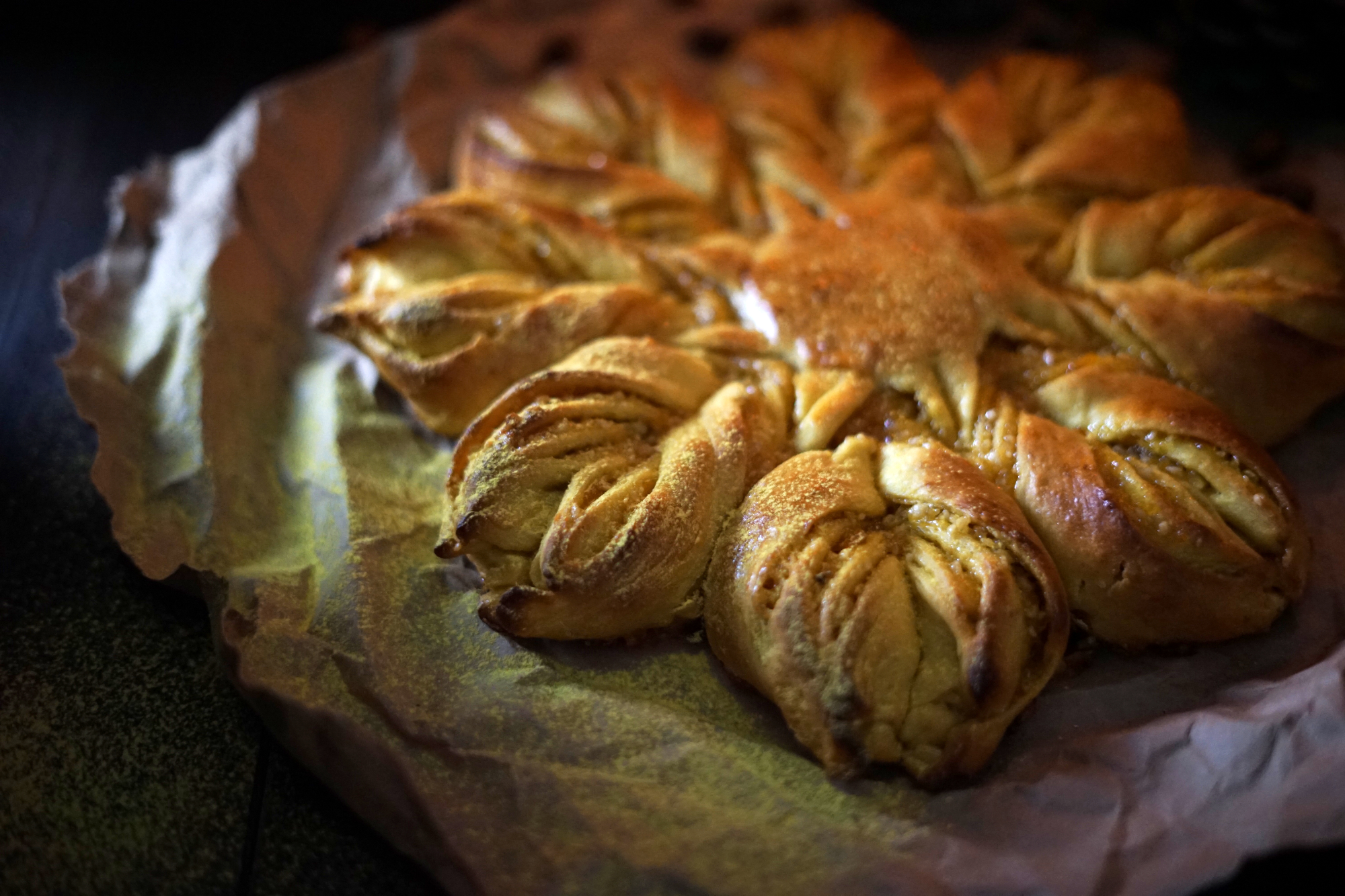Cattail Pollen Star Bread and a Winter Solstice Celebration
apricity: the warmth of the sun in winter
The darkness is a thick blanket visible at the edges. Even in the middle of the warmth and light of indoor festivities, we can sense its presence. Perhaps that is why we make such an extra effort to be jolly and merry and bright, because we know that weare in a self-created bubble and beyond it stretches a vast expanse of cold and dark.
We come together in midwinter to celebrate our communities and enjoy the bounties saved up from the summer, but we also come together out of sheer necessity - to stave off the threatening darkness. There’s a sort of stubborn resolution to our lighthearted merriment. Around the warmth of flickering flames we tell stories of miracles or stories of ghosts, and now and then we catch ourselves fading into the background and staring out the window into the alluring darkness. It is far too easy to succumb and be swallowed by it.
Perhaps this may sound like a morbid view of the holiday season, but it is one that feels so much more honest to me than the tinsel-bedecked flashing-christmas-lights of our fast-paced culture. And please do not misunderstand - the darkness is beautiful. I think we should spend less time trying to ignore it and more time examining the rich dualities of this time of year. From a nice safe warm place, preferably with good company and delicious food.
This recipe is the perfect way to celebrate the Winter Solstice. It is a hearty enriched bread made with the floral flavor and glowing color of cattail pollen, a souvenir of summer’s sunny warmth. By representing the light, it reminds us of the darkness. When we look at the color and shape of this golden star we think of both sun and night sky, and are reminded of the dark expanse that blankets us but also of the exquisite beauty of the few short hours of the day a sun low in the sky graces us with its long, angled beams of light. We celebrate the sun’s return now and know that soon enough we will start to notice the lengthening of the days once again. And together, we celebrate.
So gather with your community or your family and spend a few moments glowing in the warmth and celebrating. Take a moment to share what brings light into your life, then fill your belly with the sweet taste of the summer sun and remember: it has begun its long journey back.
Winter Solstice Warmth Ceremony:
Supplies:
one candle for each person
a lighter/matches
warm drinks
Midwinter star bread (recipe below.)
Directions:
This ceremony is simple but beautiful. Simply gather all of your guests in a circle and hand each of them a candle. Have the oldest guest light their candle and proclaim “as I light this candle I show gratitude for the return of the light to our hemisphere, and also for a source of light in my life…” Have them fill in the blank with whatever seems appropriate. Then have them light the candle of the person to their left with their candle, and have that person repeat the sentiment with their own personal response. Continue the cycle clockwise around the circle until everyone has had a chance to have their candle lit and to speak. Then speak aloud “bless this gathering of friends and family throughout the coming year. May you all embrace the light.” At this point everyone may blow out their candles, then go and have something warm to drink and a slice of Midwinter star bread.
Midwinter Star Bread:
Many versions of these gorgeous Scandinavian star breads have been making their rounds on the Internet this year, and for good reason - not only are they totally gorgeous, they’re also much easier than they look! The first time I saw one I thought how perfect they would be to celebrate the return of the sun on the Winter Solstice, so I decided to make my version a joyful yellow with the addition of cattail pollen.
Cattail pollen is a very special ingredient indeed, worth its weight in gold. It tastes like very sweet corn with a strong floral flavor that comes through in anything it is added to. The most common use for cattail pollen is pancakes, but it can be adapted far beyond that with great success. You can substitute up to 50% cattail pollen in many recipes. It is a little tricky to harvest since it’s only on the cattail plant for about a week during the late spring or early summer - you have to really keep an eye on the cattail patch to get the timing right. I harvested mine myself last summer and braved 13 leeches to do so, so this yellow powder is extra valuable to me and I save it for special occasions like the Winter Solstice.
I absolutely love the floral corn-like flavor of cattail pollen paired with perfume-y apricots and pine nuts. Enjoy it in the evening surrounded by light, or as a delicious breakfast bread served with some fresh orange juice. It tastes especially wonderful in the early darkness and altitude of anticipation of Christmas morning.
This recipe is based on the one by King Arthur Flour, with a few adaptations.
Ingredients:
1 3/4 cups all purpose flour
1/4 cup cattail pollen*
1/4 cup potato flour
1 tsp. fresh grated lemon zest
3/4 cup to 1 cup lukewarm milk (I used almond milk)
1/4 cup (4 Tbs.) butter at room temperature
1 tsp. almond extract
2 tsp. yeast
2 Tbs. honey
1 tsp. salt
Directions:
- Sift the flour, cattail pollen, potato flour, and yeast into a bowl. Add the rest of the ingredients and mix well. Knead to form a soft, smooth dough - if doing this by hand (like I do), it’s about 5 minutes of kneading. You want the dough to spring back when you poke it with your finger. It’ll be a bit faster if you use a mixer.
- Place the dough in a lightly greased bowl, cover, and let rise for an hour or until nearly doubled.
- Divide the dough into 4 equal pieces and shape each piece into a ball. Cover the balls and let rest for 15 minutes. Meanwhile, make the filling:
Filling Ingredients:
1 cup apricot jam
1/2 cup pine nuts
a little beaten egg, for brushing on the top
- Toast the pine nuts in a cast iron skillet over medium heat until fragrant, then finely chop them into small pieces. Mix into the apricot jam.
- On a piece of parchment paper, roll one piece of dough into a 10” circle. It’s okay if it’s not exactly 10” or perfectly round.
- Divide your filling into 3 equal portions. Spread one portion evenly over the surface of the dough circle, leaving 1/2” of bare dough around the perimeter.
- Roll out a second circle the same as the first and place it on top of the filling-covered first circle. Spread another portion of filling evenly over it as well. Repeat the process with the last circle, leaving the top of it bare.
- Place a 2 1/2” round glass in the center of the dough circle to act as a guide. With a sharp knife, cut the circle into 16 equal strips from the glass to the edge through all the layers. It’s easiest to do this by cutting 4 in the shape of a cross, then cutting in between each of those, then in between each of those as well. You can also use sharp scissors to make the cuts.
- Pick up two adjacent dough strips and twist them away from each other twice so that the top side is facing up again. It’s easiest to do this by holding one strip in each hand. Repeat with the remaining strips of dough so that you end up with 8 pairs of strips, then pinch the pairs of strips together to create a star-like shape with points. It’s okay if they aren’t completely even.
- Remove the glass in the middle that you used as a guide, then transfer the star (still on the parchment paper) to a baking sheet. Cover it and let it rise until it becomes puffy, about 45 minutes.
- Preheat oven to 400F.
- Brush the star with a thin coat of beaten egg, then bake it for 12 to 15 minutes or until it’s golden. Remove from oven and let cool for 10 minutes before serving. You can dust it with a little more of the cattail pollen for extra color, if you’d like.
*If you don’t have cattail pollen, just use 2 cups of flour. You can soak some saffron threads in the warm milk for 10 minutes before you add it to get a slightly more golden color.
If you want to make this bread ahead, go ahead and bake it then wrap it so that it’s airtight and place in the coldest part of your freezer. To serve, thaw overnight (still wrapped) at room temperature, then place it on a baking sheet and cover lightly with foil and reheat in a 350F oven until it is warmed through.
A note on cattail pollen amounts: I tried this recipe with a higher amount of cattail pollen ( 1 1/2 c. flour to 1/2 c. cattail pollen.) It was a deeper golden color, but didn’t hold its shape as well in the baking. The recipe as written seemed superior to me as it was more stable, but feel free to experiment with amounts a little if you’d like!
As always, if you enjoy my writings, please consider contributing to my patreon page. You can pledge whatever amount per month you are comfortable with - even $5 makes a huge difference.


















Join me for a little winter night magic as we bake this cake full of rich seasonal flavors and black cocoa!